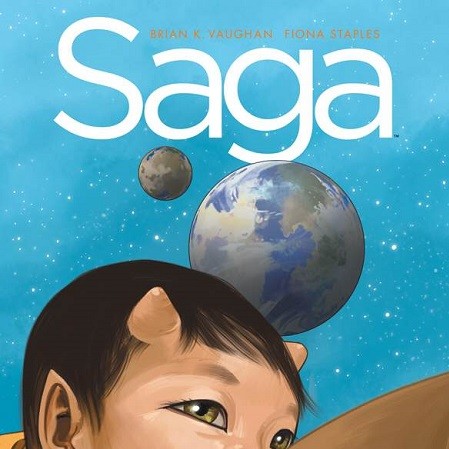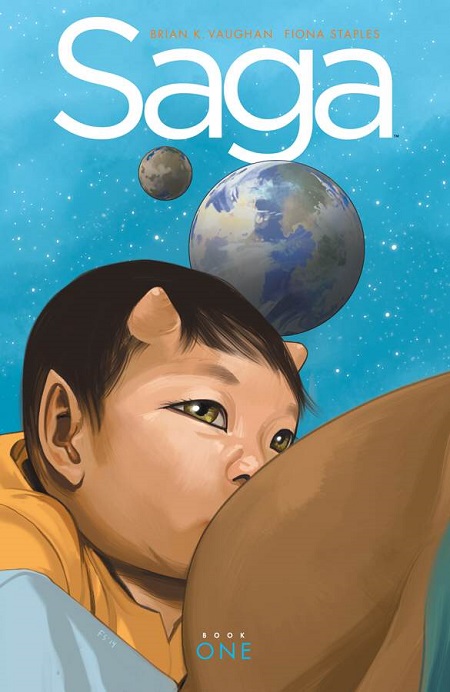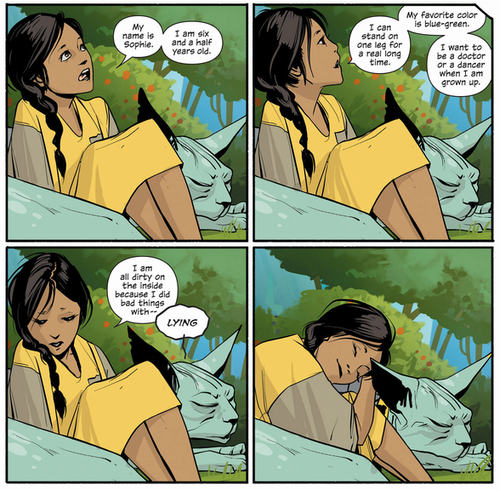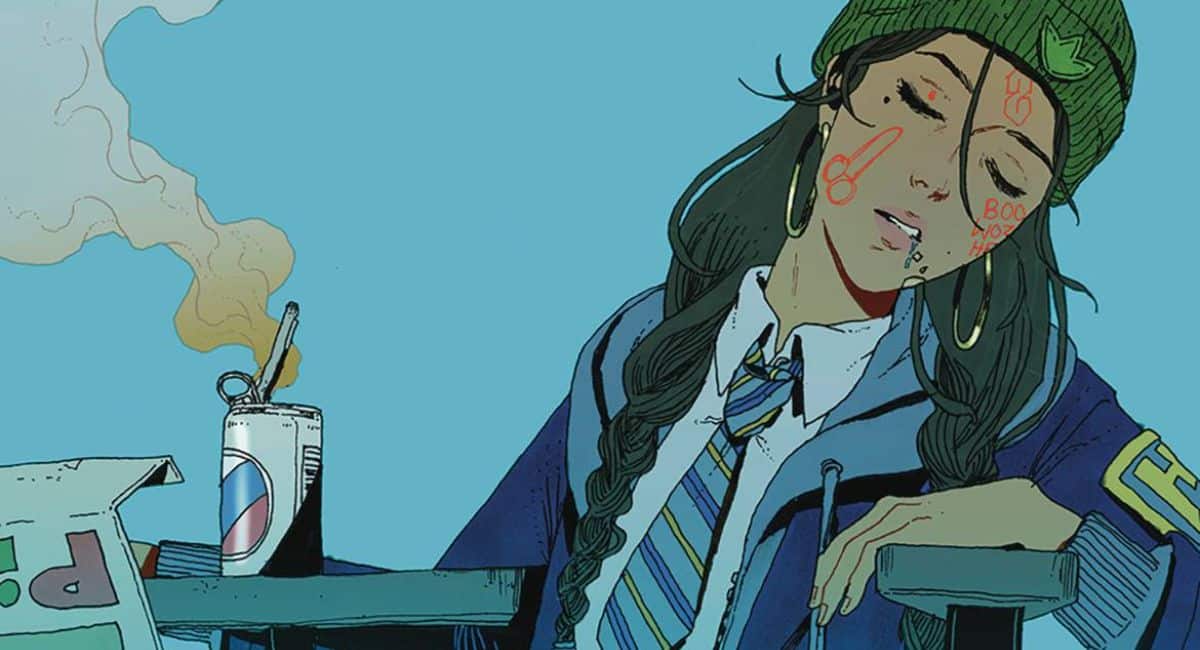by Zachary Clemente
There’s something special about Image’s book Saga. You know it, I know it, the people who voted for the Eisner awards know it – heck, my mom knows it! On Saturday of SDCC ’14, Image Comics Publisher Eric Stephenson sat down with co-creators Brian K. Vaughan and Fiona Staples to discuss their out-of-control success of a book, winner of four Eisner awards the day previous.
It was clear that Stephenson, who also edits Saga, had a set of specific questions that he knew would be interesting topics to discuss – keeping the panel at a good pace and setting an example for the sort of questions would elicit responses beyond a yes, no, or “I can’t talk about that”. He started off asking about how the book’s production has changed in the past 18 months or so, after they wrapped their first 6 issues.
Vaughan picked this up, saying that he’s learned that his job as writer has been to get out of Staples’ way as the artist. Interesting, this is exactly the approach writer Matt Fraction has with artist David Aja, to much success. Jokingly, they said that the amount of work Staples now does is much higher while Vaughan “has just gotten lazier – that’s the evolution!” In truth, however, as they’ve becoming more comfortable and confident working with each other, Vaughan has been able to really step back to showcase Staples’ ability to visualize the narrative in such a marvelous fashion.
Stephenson got them to discuss their approach to the covers of the book and the work their design and lettering collaborator, Fonographiks (aka Steven Finch). Both Staples and Vaughan are huge fans of the aesthetic of Kubrick’s 2001 and therefore found appeal with a clean style born out of a modern and minimalist approach – a character or two on top of a single color as a constant motif. For the title logo itself, they found it extremely important for it to be subdued, wanting to steer clear of the loud logos many readers are used to seeing. Instead, they wanted the logo to have an inviting and warm sensibility, welcoming readers to pick up the issues. Vaughan went on to discuss the importance of having the comics say “Chapter” instead of “Issue” on the cover and how having full control over every aspect of the book’s design was so liberating as situations like “when an ad for a goddamn Snickers bar comes in and ruins your dramatic scene” just aren’t a reality at Image.
Though a question on many a-reader’s tongue, Stephenson asked Vaughan on his stance of killing off characters in way that has gotten his work compared to the likes of George R.R. Martin or Joss Whedon.
Do I feel bad about murdering people? – Brian K. Vaughan
Vaughan first picked up the question reminding us that characters in fiction not ever dying is a recent phenomenon, as large corporations are built on top of legacies of beloved characters and the enduring support they get from fans allows them to continue – those characters just can’t die. He then goes into how Saga is kind of a way for him address anxiousness of life, fictional or otherwise, stating that “we read this stuff to prepare us for the worst.”
We’re all going to die terribly, so read our comic book! – Brian K. Vaughan
Staples and Vaughan were keen to remind the audience that Saga is fully and truly all about Hazel and though she is just a child now, she will grow and while her parents, arguably the current protagonists, are very important now – they may not be later. With that, they revealed the cover art for the first hardcover, collecting what Vaughan and Staples consider to be the first chapter of the series – issues 1-18 or trade volumes 1-3.
The cover, with a very prominent close-up of Hazel breastfeeding from Alana is a clear response to the backlash the book received when the first cover was revealed – showing the young couple with child to Alana’s breast. They had this to say on the subject:
Just doubling-down on our breastfeeding stance, aren’t we? – Fiona Staples
Some stores won’t even rack the first volume because the breastfeeding is controversial, but…fuck them. – Brian K. Vaughan
The panel was then opened up to Q&A from the audience. Most questions pertained to the plot, the possibilities of merchandise such as shirts, toys, plush dolls, and the alike – most of which were given expected answers of uncertainty. There will not be another run of the Lying Cat shirts, but they are not opposed to high-quality merchandise.
Additionally, when asked about their feelings of the possibility of an adaptation into another medium such as film or television Brian explained, not for the first time, that though he has worked in both other industries, he finds comics to be the vastly superior medium – though would not be opposed if they received an offer they just couldn’t say no to. Staples eagerly suggested, when queried, that the best game adaptation would be a Dungeons & Dragons styled tabletop roleplaying game to much applause.
One attendee brought up a point that’s been stewing in at least my head, which is the apparent and thorough multiculturalism represented in Saga. Vaughan honestly answered that it’s something he has to be keenly cognizant of as, when first writing the book, it took him a while to realize that “white” didn’t have to be the default. Apparently, when designing Alana, he told Staples that she shouldn’t be a red-head as “there are a glut of red-heads right now.” When she responded with “you know, she doesn’t have to be white,” he let out a defeated and embarrassed “oh…right.”
Another attendee brought up the page in issue 14, where lying cat devastated a whole readership in one day.
While they approached this page like any other, Vaughan used this to discuss how, as a child, he found the iconic Slave Leia costume featured in Star Wars not sexy, but subjugated. His distaste for it is apparent with his wish to attempt to portray more realistic situations when war affects civilian life. I personally find this a fantastic stance on the subject and deeply appreciate that he’s coming from this sort of perspective.
Why do the robot people have dicks and stuff? – The next Attendee
The person asking this question did preface it with the fact that it was less touching. It did, however launch the duo into a discussion of soft sci-fi and how Saga is a romantic drama, wrapped in the trappings of a space epic.
Lastly, it was revealed that one of the main reasons that much of the technology in this book isn’t necessary metal spaceships and laser guns is because Staples doesn’t really enjoy drawing any of that – so Vaughan had to compensate, all for the better.
Overall, this was a Saga fan’s dream come true. Vaughan and Staples were receptive, amiable and inviting. They clearly have a spectacular rapport that’s equal parts professional and loving – they’ve put everything and more they have into this book and it clearly shows. As a fan, I’m loving it and as someone deeply invested in seeing comics grow and evolve, I’m in for the long haul. Thanks to Eric Stephenson for moderating with a charming ease, keeping the flow casual and friendly.










I love Saga! Have every issue, the trade paperbacks, and will probably buy the Hardcover when it comes out as well…..wear both a white and black Lying Cat t-shirt with pride!
Anyway, I thought that scene from issue 14 was an awesome evolution of Lying Cat’s character into something greater! It made me tear up….
That page showcased above with lying cat and little girl is one of my favorite pages in a comic book ever. What a page, I loved the series already, but that page blew me away.
Comments are closed.